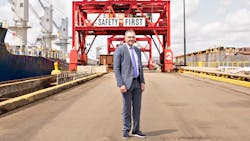Bringing Manufacturing to Construction: A Modular Response to Homebuilding Woes
Caption for above photo: Roger Krulak, founder and president of construction company FullStack Modular.
Affordable housing is too expensive in the United States because there's just not enough of it to go around. Roger Krulak thinks he has a solution--manufacturing.
“We as a country are failing to provide attainable housing. Full stop,” says Krulak, owner of a company that builds homes in factories. “The conventional process that we’ve used for decades is inefficient, slow and expensive, so we need a set of answers, and industrialized construction, done correctly, is an answer to faster construction, cost effective construction, predictable timing … As a result of that, both publicly and privately [modular] is getting a lot of attention.”
About Modular
Modular construction refers to the prefabrication of buildings in an off-site facility. The factory will produce standardized sections or modules of the building to allow for assembly of the completed sections on site.
There is also a distinction to be made between modular homes and manufactured homes: Modular homes are built to local codes, while manufactured homes are built to the HUD code, a federal standard.
Benefits of Modular
Building homes on vacant lot is tough. The environment is chaotic and unpredictable, and virtually no processes are repeatable. The main advantage to modular is stability. It happens indoors in a factory where workers can follow standard procedures.
According to FullStack Modular, Krulak’s company in Connecticut, developers can anticipate 80% greater time and cost certainty, 20% to 50% faster development and up to 25% lower building cost with modular.
Efficiency can also lead to sustainability benefits. “Integrating renewable energy, etc., is very easy in our process because we’re doing it in the same place,” he says. Krulak also touts the low carbon footprint. For example, FullStack Modular reports their process produces material waste under 5%, which is 67% less waste than conventional construction on a typical project.
Compared to traditional construction, Krulak says the job is more stable. “You come to the same place every day; we attract people with families.”
Safety is another huge component for workers. Working at ground level and inside a building rather than outside results in 70% safer work conditions, according to FullStack Modular. “You’re never much more than 30 inches off the ground,” Krulak says.
Growth Opportunities
“The federal government and some local governments are getting more creative and resourceful about what affordable housing looks like,” says Jay McCanless, senior vice president of equity research at Wedbush Securities.
McCanless, who covers the homebuilders and building products sectors, recognizes the geographic advantages to modular, citing the northeastern U.S. in particular. “When you’ve only got two months of the year where you can dig a foundation, you’ve got to hurry with the construction side of it, so modular fits that really well,” he says.
The increasing prominence of modular could also be inspired by the international use of the process. Modular housing and techniques are used in places like Japan, Germany and Scandinavian countries, he says.
While much talk of modular centers around residential uses, other creative applications have been introduced. McCanless cites examples like portable hospitals during the COVID pandemic and disaster relief. “I would think for modular, if there’s a growth area, it’s going to be in niches like that,” he says.
There are also opportunities that are mostly untapped, according to McCanless. “What we haven’t seen, to a large extent in some of these markets that we cover, is you haven’t seen a lot of brownfield redevelopment with some of these larger malls, etc., that need to get knocked down and some type of housing or mixed use or something put behind it,” he says. “To me, that’s a great opportunity for modular because you’ve got the space to work.”
FullStack Modular Operations
Krulak, founder and president of FullStack Modular, describes the company as a “design, manufacture, construct solution for multifamily building focused on mid to high-rise … generally focused on dense urban environments.”
FullStack Modular recently moved its U.S. headquarters and manufacturing center from Brooklyn to Hamden, Connecticut. It also has a factory in Oregon to serve the West Coast.
As a fully integrated solution, FullStack Modular uses a design for manufacture (DFM) process, meaning elements are purposely designed in a way that optimizes the manufacturing process and reduces costs. DFM has the ultimate goal of “embracing the industrialized construction aspect, increasing economies of scale, speed and cost effectiveness,” Krulak says.
Krulak isn’t the only one embracing modular construction. According to Exactitude Consultancy, the global modular construction market is expected to reach $139.03 billion by 2029. Additionally, in May, Finnish company Admares announced plans for a $750 million modular housing plant in Waycross, Georgia; the factory is expected to produce 5,000 to 6,000 homes per year, according to the Associated Press.
Future Prospects
Although McCanless says it can be difficult to track modular because it is built to local code, he sees concrete room for growth in the market, especially for urban environments.
“Any of those applications where you need a lot of rooms quickly, I think the need for that is only going to go up … Being able to manufacture those safely in the factory, I think that’s only going to gain steam over time,” he says.
Krulak and others like him have revolutionized the construction space for workers and consumers, and he says modular is finally getting the overdue recognition it deserves.
“The bottom line is that embracing industrialization, for any need that exists, is something that we as a society, as intelligent humans, should be doing,” Krulak says. “The need for housing is basically endless … this isn’t like, ‘I’m the biggest innovator in the world,’ I’m just somebody standing up saying, ‘Hey, pay attention! Here’s the problem, here’s the solution.’”
About the Author
Anna Smith
News Editor
News Editor
LinkedIn: https://www.linkedin.com/in/anna-m-smith/
Bio: Anna Smith joined IndustryWeek in 2021. She handles IW’s daily newsletters and breaking news of interest to the manufacturing industry. Anna was previously an editorial assistant at New Equipment Digest, Material Handling & Logistics and other publications.

